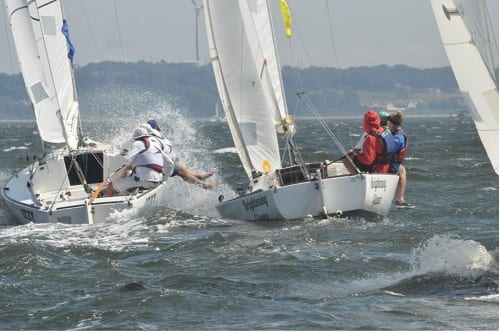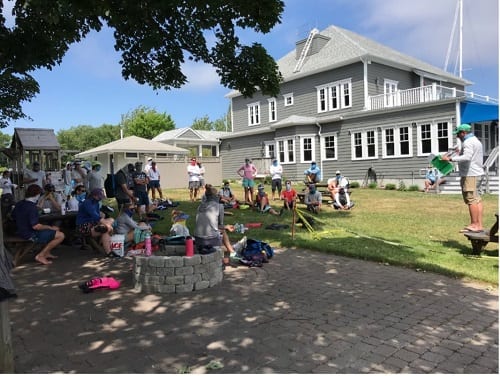Growing Club Participation Through Team Racing
A Case Study by Nick Cromwell
Located on the upper Narragansett Bay, less than 20 miles north of Newport, is Bristol Yacht Club (BYC) and the East Bay Sailing Foundation (EBSF). BYC is an “up and comer” in the team race keelboat scene. BYC has been steadily building the team race program for a couple of years by combining the resources of EBSF with those of the club and catalyzing the enthusiasm of members. As a result, they have seen an influx of young members looking for affordable ways to stay involved with the sport. Folks under 25 years old can join the club for $100, and the under 30 crowd can join without an initiation fee.
The East Bay Sailing Foundation is the public, sailing education arm of BYC. To support its “learn to sail” mission, the EBSF accepted its first donated J22 in 2013. From there, the club acquired five more boats. Soon, individual members were also jumping on the J22 train by buying boats to help build up the fleet, which is now comprised of six club boats and seven member owned boats for a total of 13. After EBSF uses the boats during the day to teach junior sailing, the boats are used in the evening to teach adults and for the BYC racing program which includes: a Monday night team race league; Wednesday night PHRF racing; and Thursday night one-design series. Having evenly matched boats is essential for building a team racing program, and Bristol Yacht Club has been able to build a balanced fleet by uniting the education activity and the racing activity to maintain it. They’ve also just purchased new suits of sails that will be a shared asset for club racing and instruction.
Former Chair of EBSF and BYC board member Nick Cromwell has been spearheading the team racing vision, but he’s got some local team racing enthusiasts helping to bolster momentum. Team Racing World Champ Pete Levesque (captain of the Thursday Night fleet race series) is helping with Hinman preparation for the 2021 US Sailing Team Racing National Championship while Roger Williams University Head Coach, Amanda Callahan, is recruiting recent college grads to get involved. Having a core group of team race stalwarts has led to a vibrant fleet racing and team racing scene that keeps the adult members engaged and attracts new and younger members as well.
Last summer, BYC was one of the few clubs that managed to run fun, safe team races in the COVID environment. The “New Normal” Team Races were a departure from the typical full weekend worth of racing. New Normal racing consisted of a half day of condensed racing for 4 teams with no boat rotations which made for super-efficient racing. They were such a hit that the New Normal events will be back again this summer but will be even better with the addition of a more social post-race debrief!

- Start with a vision of how team racing can attract new members or engage existing member in more activities.
- Develop a plan for equipment and long-term support and maintenance. First, you need to start with the infrastructure, going out and buying a matched fleet of boat is ideal, but certainly not an option for most clubs.
- Consider using the boats for multiple uses, fleet racing, adult and junior instruction, day sailing, as well as team racing can involve more members and generate additional income to maintain the boats.

- Having a small fleet of evenly matched boats is critical and central to a successful team racing program. Acquiring 4-6 closely matched boats can be augmented with member owned boats or pair up with another club close by with similar interest. Sonars, J22s, Ideal 18s, and Harbor 20s are popular keelboat choices. Rhodes 19s or Flying Scotts might be found more readily in your area and can also work for team racing. Of course, dinghies like 420s or FJs will do the trick too.
- If you have a non-profit organization that can help out, get them engaged! In our case, East Bay Sailing Foundation is a non-profit and has the ability to take donations and fundraise which can be helpful to fleet acquisition and maintenance. They have acquired boats both through direct donation and by purchase through fundraiser proceeds.
- To support the racing, you’ll need powerboats, three is a good start: one for RC; one or two for umpires/mark set if you are racing on a port box with umpires or two for start/finish boats; and one for mark set on an un-umpired Digital N course. (Umpiring is not required, so don’t be afraid to start small.) Powerboats are another item where shared resources with an instructional program or private boats makes it easy to get going.
- You will also need 5-6 small-sized racing marks, preferably six if you plan to race on a Digital N course. Large tetrahedrons are too big and cumbersome for a racecourse that is 12 minutes long.
Team racing has a grass-roots origin story; keep it simple as you build your program, and it will flourish! Bristol Yacht Club is set to host the U.S. Team Racing Championship in September for the Hinman Trophy later this year. Follow the event, and if you are a team racing fanatic aficionado, apply to compete and take your chances against the best of the best!!

Please visit One Design Central for more one design sailing resources and information.

